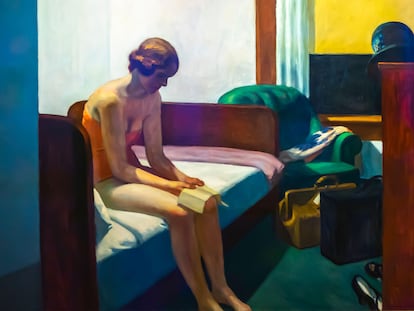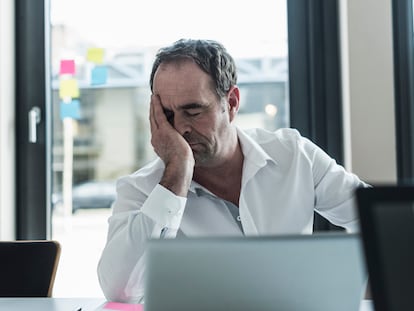Fantasizing about stopping: The debate about slowing down the pace of life
Several books and essays analyze the need many people feel to take a break, disconnect from their cell phones, and enjoy life without the internet

As Stefan Klein points out in Time: A User’s Guide, each person is born with a rhythm programmed between day and night. However, in everyday life, people orient themselves by minutes and hours, which are not natural units of measurement for internal time.
“Normally, we imagine time as a uniform soup, with each spoonful tasting the same as the rest of the bowl. We think of 60 seconds as a minute; 60 minutes as an hour; 24 hours as a day. And each unit is merely a fraction of the larger unit. However, our experience of time works differently,” the author asserts.
Klein also comments that internal time is independent of the ticking of mechanical clocks and also of the biological clock, and that each person experiences every day that their consciousness takes the liberty of creating its own time. “If this were not the case, we wouldn’t need a device on our wrist to tell us the time,” he says.
So, for example, when the blackout in Spain and Portugal put everything on hold for a few hours, time took on a new meaning. That temporary pause without an internet connection felt eternal for many, as they wondered what they would do without being able to work, constantly check their social media, or stream Netflix. Because although time is the most valuable thing, as it can’t be bought, we’ve become accustomed to “passing time,” not necessarily living it.
However, after the initial shock, many embraced the opportunity to do something that until then seemed impossible in a frenetic world: stopping. The debate that began during the coronavirus lockdown was back on the table.
“The baking frenzy during quarantine can be explained by the need to fill idle hours, the craving for applause on social media, and the search for a natural anti-anxiety remedy,” Begoña Gómez Urzaiz tells EL PAÍS. Even though the world continued to accelerate upon returning to “the new normal,” the pleasure of taking a break and the love of life on a slow burn resonated with many people.
Fabián León, who recently opened FU. BA — Future Bakery — in Madrid, speaks of the power of advocating for slowness. “What we do in the bakery is precisely to emphasize the importance of quality, and in doing so, we seek an experience of conscious calm. For me, there’s nothing more atavistic than bread: it connects us with something we can’t explain,” he says.
Eva Morell recently published Refugio, an ode to silence in times of hyperconnection in which the author explores the cabin as an intimate and collective symbol of refuge, pause, and reconnection. She explains that although perhaps no one actually emerged better from confinement, seclusion helped to reconnect with the natural environment. “Suddenly, we understood that disconnection was necessary, that the analog world wasn’t so bad, and that from a getaway to the countryside, we could return with our lungs full of fresh air and our brains reset,” she says.
Also arriving in bookstores now is No Straight Road Takes You There, where Rebecca Solnit pays tribute to slowness and the power of patience. “Most truths are like that, easy to hear or recite, hard to live in the sense that slowness is hard for most of us, requiring commitment, perseverance, and return after you stray. Because the job is not to know; it’s to become,” says the author in a text published on Literary Hub. “I’m an advocate for slowness, not in the sense of dragging your feet or delaying your reaction but in the sense of scaling your perception to perceive the events unfolding, because I’m an advocate for making change,” she notes.
Eva Morell believes that society is beginning to realize the need to disconnect. “There’s a very noticeable increase in Google searches about how to disconnect from your phone and escape routine and the city. We’ve created this need to disconnect,” she explains to EL PAÍS. She believes Jenny Odell was the architect of this movement.
In How to Do Nothing, Odell writes: “I hope that the figure of ‘doing nothing’ in opposition to a productivity-obsessed environment can help restore individuals who can then help restore communities, human and beyond. And most of all, I hope it can help people find ways of connecting that are substantive, sustaining, and absolutely unprofitable to corporations, whose metrics and algorithms have never belonged in the conversations we have about our thoughts, our feelings, and our survival.”
The book continues: “To capitalist logic, which thrives on myopia and dissatisfaction, there may indeed be something dangerous about something as pedestrian as doing nothing: escaping laterally toward each other, we might just find that everything we wanted is already here.”
But in Saving Time: Discovering a Life Beyond the Clock, Odell emphasizes that when she talks about doing nothing, she isn’t advocating absolute inactivity, but rather a state of openness to the world.
“Many authors talk about this, and I think it’s important for women to address this issue, because we’re so wrapped up in productivity, doing everything right, being our own bosses, and being successful, so our bodies tell us to slow down at some point,” says Morell.
In Manifesto para la calma (Manifesto for Calm), Miguel Navarro agrees, pointing out that most people confuse productivity with “doing more things.” “They think that if they fill every minute and have endless to-do lists and end up exhausted every night, they’ve been productive. Nothing could be further from the truth. They confuse movement with progress,” he asserts.
“They also fall into the trap of multitasking, believing that doing several things at once is being efficient. In reality, it’s the best way to do everything wrong. Their energy is dispersed, their mind becomes fragmented, and, in the end, their impact is minimal. As if that weren’t enough, they believe the secret is working more hours. And so they burn their days, their nights, and, ultimately, their motivation, because no one can endure years in sprint mode. True productivity isn’t about pushing harder, it’s about pushing better, but almost no one understands this. And that’s why they live busy lives, but don’t make progress,” he asserts. The author clarifies that the calm he advocates doesn’t mean stopping, pausing, letting things go, or having more free time. “That’s a false calm. True calm is mental, emotional, and spiritual calm,” he says.
Essayist Pedro Bravo, author of Silence, points out that haste is already part of our social behavior. “We live in a fast-paced and noisy society, both sonically and mentally. The need to earn a living forces us to go very fast and to be in a state of almost permanent restlessness. When we talk about mental health problems, little is said about the structural causes of many of them, and inequality and the tension imposed by the economic model are one of them,” he reflects. “We have been told that living life is doing a lot of things, but I agree more with the philosopher Josep María Esquirol, who says in his book La resistència íntima [Intimate Resistance], ‘living is not living, but realizing.’"
Bravo asserts that silence is a form of resistance. Eva Morell completely agrees. “As another writer, Beatriz Serrano, says, silence has become a luxury, so I think it’s a form of resistance.” Because in a world that screams and accelerates, being quiet and slowing down is an absolute pleasure — one that, of course, carries a degree of privilege, but is still worth striving for. The algorithm has taken over our leisure time, and society seeks to quickly achieve micro-pleasures, which gives rise to omnipresent anxiety. In response, more and more people are rebelling by taking their foot off the gas and taking their mind off multitasking.
Sign up for our weekly newsletter to get more English-language news coverage from EL PAÍS USA Edition
Tu suscripción se está usando en otro dispositivo
¿Quieres añadir otro usuario a tu suscripción?
Si continúas leyendo en este dispositivo, no se podrá leer en el otro.
FlechaTu suscripción se está usando en otro dispositivo y solo puedes acceder a EL PAÍS desde un dispositivo a la vez.
Si quieres compartir tu cuenta, cambia tu suscripción a la modalidad Premium, así podrás añadir otro usuario. Cada uno accederá con su propia cuenta de email, lo que os permitirá personalizar vuestra experiencia en EL PAÍS.
¿Tienes una suscripción de empresa? Accede aquí para contratar más cuentas.
En el caso de no saber quién está usando tu cuenta, te recomendamos cambiar tu contraseña aquí.
Si decides continuar compartiendo tu cuenta, este mensaje se mostrará en tu dispositivo y en el de la otra persona que está usando tu cuenta de forma indefinida, afectando a tu experiencia de lectura. Puedes consultar aquí los términos y condiciones de la suscripción digital.
More information
Archived In
Últimas noticias
There is as much life left to discover on planet Earth as that which is already known
Dozens presumed dead, around 100 injured in fire at Swiss Alps bar during New Year’s celebration
Is porn for women different from conventional porn? We spoke to those who make it
Cartagena de Indias is sinking: What can the city do to mitigate it?
Most viewed
- Reinhard Genzel, Nobel laureate in physics: ‘One-minute videos will never give you the truth’
- David King, chemist: ‘There are scientists studying how to cool the planet; nobody should stop these experiments from happening’
- Oona Chaplin: ‘I told James Cameron that I was living in a treehouse and starting a permaculture project with a friend’
- Sinaloa Cartel war is taking its toll on Los Chapitos
- The Interoceanic Train, the Mexican alternative to the Panama Canal











































